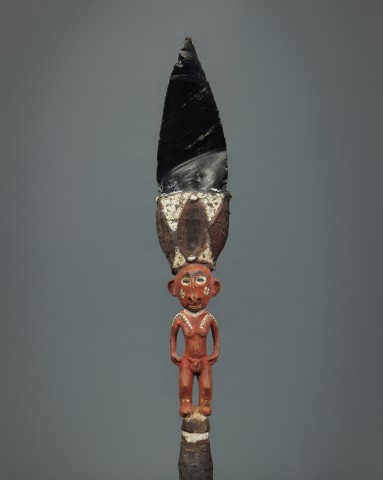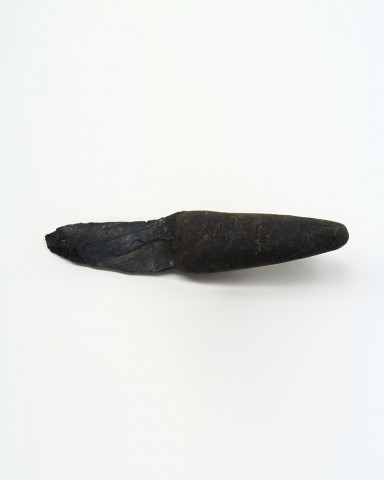2002 North Main Street
Santa Ana, California 92706
TEL: 714.567.3600
Dragon Glass: Taking Stock at the Bowers Museum
 |
| Battle and Hunting Weapons, 300-1519 Michoacán, Mexico Obsidian; various dimensions 2003.10.42C-I Anonymous Gift |
The Night King Cometh
As most fantasy buffs are well¬-aware, HBO’s Game of Thrones returns for the first of its final six episodes this upcoming Sunday. Not to spoil too much of the show for those who are interested in watching but have not yet found the opportunity in the almost eight years since the first episode aired, the protagonists are in a decidedly tight spot and obsidian—called dragon glass in Westerosi vernacular—has already been a substantial boon to the protagonists’ righteous cause of keeping the zombiesque White Walkers at bay. In this post we look at the Bowers Museum’s preparedness given the onset of an obsidian-related catastrophe on planet earth.
 |
| Dragon glass as seen in HBO's Game of Thrones. |
Any Color you Want, as Long as you Want Obsidian
To better understand our odds of survival perhaps it makes good sense to begin by examining the prevalence and formation of obsidian, as it also helps explain why the Bowers has obsidian objects from all around the globe. The black volcanic glass is formed when certain lava varietals are cooled quickly enough that they vitrify rather than crystallize. This is a common-enough process that obsidian can be found just about anywhere that has had volcanic activity in the past million or so years—much longer and the glass will crystallize and decay. In relative terms, the earliest of the 2,039 obsidian objects in the Bowers Museum collections are not that old. In fact, relatively speaking almost no obsidian objects that still exist are that old, as archaeological evidence shows that obsidian tools have been used for at least 700,000 years.
 |
| Projectile Point, date unknown Courreges Ranch, Fountain Velley, Orange County, California Obsidian; 1 5/8 × 3 1/4 in. 2922 Gift of Mr. John E. Courreges |
Hodor
What we can say about the early obsidian at the Bowers Museum is how it was used. Often the form and particularly the pattern of chipping lend evidence to function. Far and away the bulk of the Bowers obsidian objects are pre-Columbian pieces from Mexico and Native North American sites in Southern California. As one might expect of glass, after only minor working obsidian is razor-sharp. The usage of stone tools to shape obsidian by chipping also meant that all early obsidian blades were serrated, a feature which only served to excel its cutting ability. Hypothetically if one was lacking a friendly giant to keep an undead army at bay, much of the Bowers’ obsidian collection could be wielded in self-defense. In real terms, a large portion of the collection was intended for use as weapons. The introductory image for this post shows a subset of seven pre-Columbian weapons for battle and hunting from a larger donation of twenty-five. Already by the 12th Century groups in Michoacán had perfected the art of producing weapons from obsidian cores. Used by themselves or socketed into weapons like the macuahuitl, a wooden club ridged by obsidian blades, each of these twenty-five objects would have been immensely deadly.
| Weapons and Carving Tool, 19th to 20th Centuries Admiralty Islands, Bismarck Archipelago Manus Province, Papua New Guinea, Melanesia Wood, obsidian, resin, fiber, trade bead and stingray spine; various dimensions 2016.2.1, 2004.35.3 and 2017.10.42 Bowers Museum Purchase and Anonymous Gift |
Glass-Cut
It is important, however, how varied the usage of obsidian was. Still solely within the realm of utilitarian objects, the Bowers Collections includes projectile points, blades, scrapers, drills and more. To take a specific case, the Bowers has several spears from Lou Island, a major source of obsidian located just north of Papua New Guinea, but as the Bowers Blog has previously noted in Grand Admiralty Island Feast Bowl, the volcanic glass was more important in woodcarving. Its prevalence led Lou Island to become a regional center for bowl-making and offered it valuable trade capital.
 |
| Faceted Agate Container © 2010 Harold and Erica Van Pelt |
Castle Black
Given that our world’s dragon glass has never observably demonstrated the supernatural benefits seen in Game of Thrones, the durability of metal tools essentially made the volcanic mineraloid obsolete as a utilitarian medium. However, given the attractiveness of its midnight color, obsidian has been used for its aesthetic qualities since approximately 8,000 years ago when decorative obsidian beads were polished around the same time it was first used in mirrors. This aesthetic function has continued to develop over time. Now on the other side of the eight-millennium time jump, gemstone carvers like Harold Van Pelt are still using the glass in works such as his faceted agate container on an obsidian base. Talented as Van Pelt is, his sculptural works would almost certainly not be of much use to Game of Throne’s Night’s Watch in combat, but their beauty might help boost morale.
Text and images may be under copyright. Please contact Collection Department for permission to use. References are available on request. Information subject to change upon further research.




Comments 1